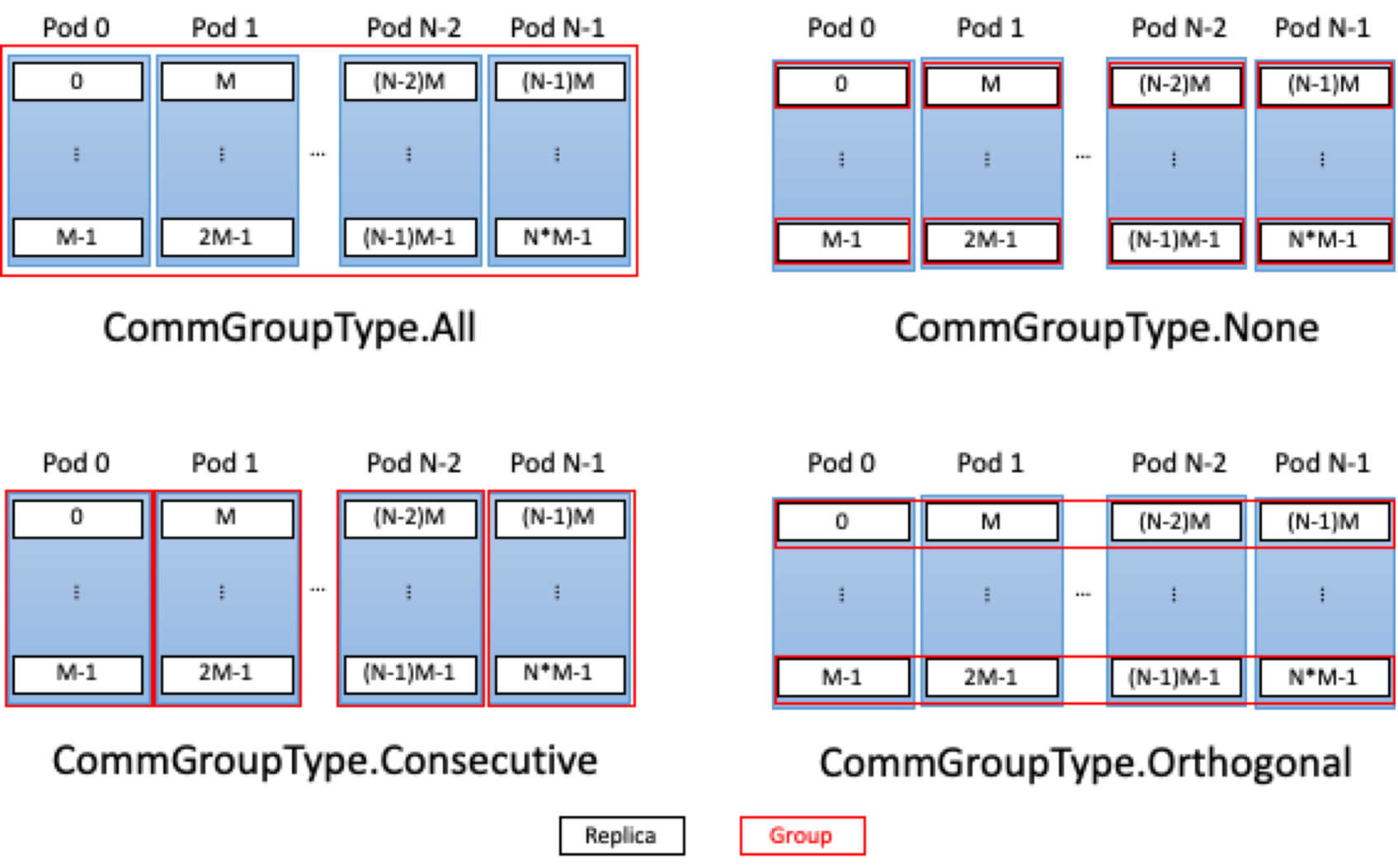7. Grouping graph replicas
This section details how to use the popart.VariableSettings class for
the purpose of grouping tensor weights across replicas.
For a detailed description of what a replica is, refer to the
Replication section in the IPU Programmer’s Guide.
7.1. Concept
When using graph replication, variables by default contain the same value on all
replicas. With the help of VariableSettings, we can assign
distinct tensor values to and retrieve tensor values from groups of
replicas, removing the limitation of assigning the same value to all replicas.
7.2. VariableSettings
The VariableSettings object is initialized with two values:
a CommGroup and a VariableRetrievalMode.
CommGroup is used to set the communication groups this tensor is divided into across replicas,
and VariableRetrievalMode lets you specify how to retrieve variables from the replicas.
The CommGroup class is composed of the CommGroupType enum,
and the size of each group. Possible values for CommGroupType are:
popart.CommGroupType.All: This is the default group type in which all replicas are considered to be a part of one group. This means that all replicas use the same variable values. ThisCommGroupTypeignores group size. An example of such a grouping is shown in Table 7.1 and in Fig. 7.1.Table 7.1 Replication factor 16, CommGroupType = All Group
Replicas
0
0, 1, 2, 3, 4, 5, 6, 7, 8, 9, 10, 11, 12, 13, 14, 15
popart.CommGroupType.Consecutive: Adjacent replicas (based on replica index) are grouped together. Each group has a size equal to the sizeCommGroupis instantiated with. For example, for 16 replicas (replica index = 0 to 15) and a group size of 4, the groups are assigned as shown in Table 7.2 and in Fig. 7.1.Table 7.2 Replication factor 16, CommGroupType = Consecutive, CommGroup size = 4 Group
Replicas
0
0, 1, 2, 3
1
4, 5, 6, 7
2
8, 9, 10, 11
3
12, 13, 14, 15
popart.CommGroupType.Orthogonal: Replicas are assigned to groups with a stride defined by the number of groupsnum_groupswhere \(num_groups = \frac{number of replicas}{group size}\). For example, for 16 replicas (replica index = 0 to 15) and a group size of 4, there will be four groups and they are assigned as shown in Table 7.3 and in Fig. 7.1.Table 7.3 Replication factor 16, CommGroupType = Orthogonal, CommGroup size = 4 Group
Replicas
0
0, 4, 8, 12
1
1, 5, 9, 13
2
2, 6, 10, 14
3
3, 7, 11, 15
popart.CommGroupType.None: Each replica is in its own group. For example, for 16 replicas (replica index = 0 to 15), the groups are as shown in Table 7.4 and in Fig. 7.1.Table 7.4 Replication factor 16, CommGroupType = None Group
Replicas
0
0
1
1
2
2
…
…
14
14
15
15

Fig. 7.1 How replicas across multiple Pods are assigned to groups for the different CommGroupTypes values. There are N Pods and each has M replicas. Replicas are numbered sequentially down each first before moving across to the next Pod.
7.3. Instantiating variables with VariableSettings
The number of replicas, the replication factor, is needed to create variables with popart.VariableSettings
because the number of communication groups requiring initialization, and thus
the size of the instantiating buffer, depends on the replication factor.
popart.VariableSettings can be added to the call to the builder function
addInitializedInputTensor() when initiating your variable.
The instantiating buffers used for creating these variables have to be sized such
that they initialize each group individually. This is done by adding an outer
dimension to the instantiating buffer equal to the number of groups, and the
graph builder will handle the rest. For example, a tensor with shape [2, 3,
4] and a replication factor that results in four groups must be instantiated
with a shape of [4, 2, 3, 4], where [r, ...] instantiates the variable on replica r.
7.4. Weight input/output
When using PyWeightsIO to read the value of the weights, the instantiating buffer size must match the size of the initializing data, and if
VariableRetrievalMode is
AllReplicas, the outer dimension must
match the replication factor.
For example, using VariableSettings with a tensor of shape [2, 3, 4], a replication factor of 4
and CommGroup instantiated with Consecutive and a group size of 2, we need a buffer for
PyWeightsIO with one of the following shapes:
[2, 2, 3, 4]if we usepopart.VariableRetrievalMode.OnePerGroup.
[4, 2, 3, 4]if we usepopart.VariableRetrievalMode.AllReplicas.
The on-device buffer is populated by the session readWeights() function for training or
for inference.
Listing 7.1 shows an example of creating buffers for replicas.
# Copyright (c) 2022 Graphcore Ltd. All rights reserved.
import popart
import numpy
from popart import CommGroup, CommGroupType
from popart import VariableRetrievalMode, VariableSettings
builder = popart.Builder()
# replication factor
repl_factor = 4
# Simple base shape of variable on replica
base_shape = [3, 5]
# size of each group
group_size = 2
# The CommGroup we plan to use
communication_group = CommGroup(CommGroupType.Consecutive, group_size)
# VariableSettings to read from groups
settings_grouped = VariableSettings(
communication_group, VariableRetrievalMode.OnePerGroup
)
# VariableSettings to read from all replicas
settings_individual = VariableSettings(
communication_group, VariableRetrievalMode.AllReplicas
)
# get init buffer:
num_groups = settings_grouped.getGroupCount(repl_factor)
shape = [int(repl_factor / num_groups)] + base_shape
initializer = numpy.zeros(shape).astype(numpy.float32) # example
print(initializer.dtype)
# Creating Variables
a = builder.addInitializedInputTensor(initializer, settings_grouped)
b = builder.addInitializedInputTensor(initializer, settings_individual)
# get IO buffer shapes
shape_a = [settings_grouped.numReplicasReturningVariable(repl_factor)] + base_shape
shape_b = [settings_individual.numReplicasReturningVariable(repl_factor)] + base_shape
# get IO buffers
buffer_a = numpy.ndarray(shape_a)
buffer_b = numpy.ndarray(shape_b)
# finalize IO buffers
weightsIo = popart.PyWeightsIO({a: buffer_a, b: buffer_b})
7.5. ONNX checkpoints
ONNX is not, by default, aware of the replication factor. Therefore, the ONNX model will attempt to interpret the outermost dimension as a part of each replica. This will usually break the logic of the model.
To address this, the builder function
embedReplicationFactor() writes the replication factor
into the ONNX model as an attribute of the graph.
The builder does not need the replication factor embedded when using
resetHostWeights() for training or
for inference to
write an ONNX file into a new model.